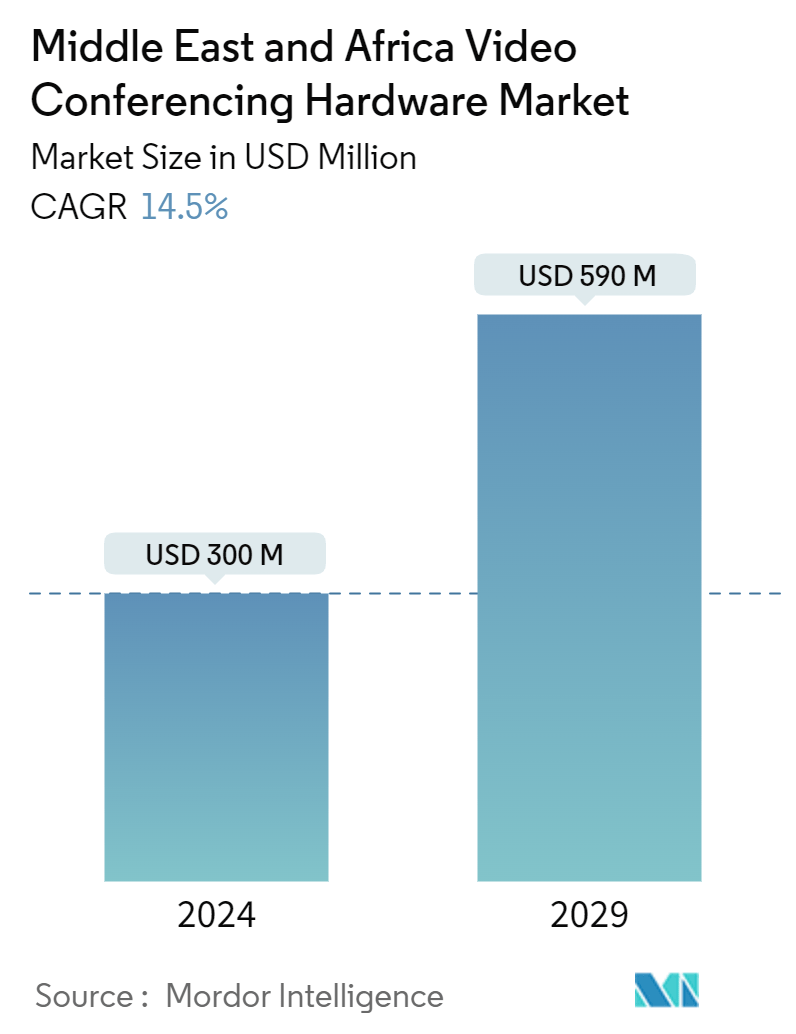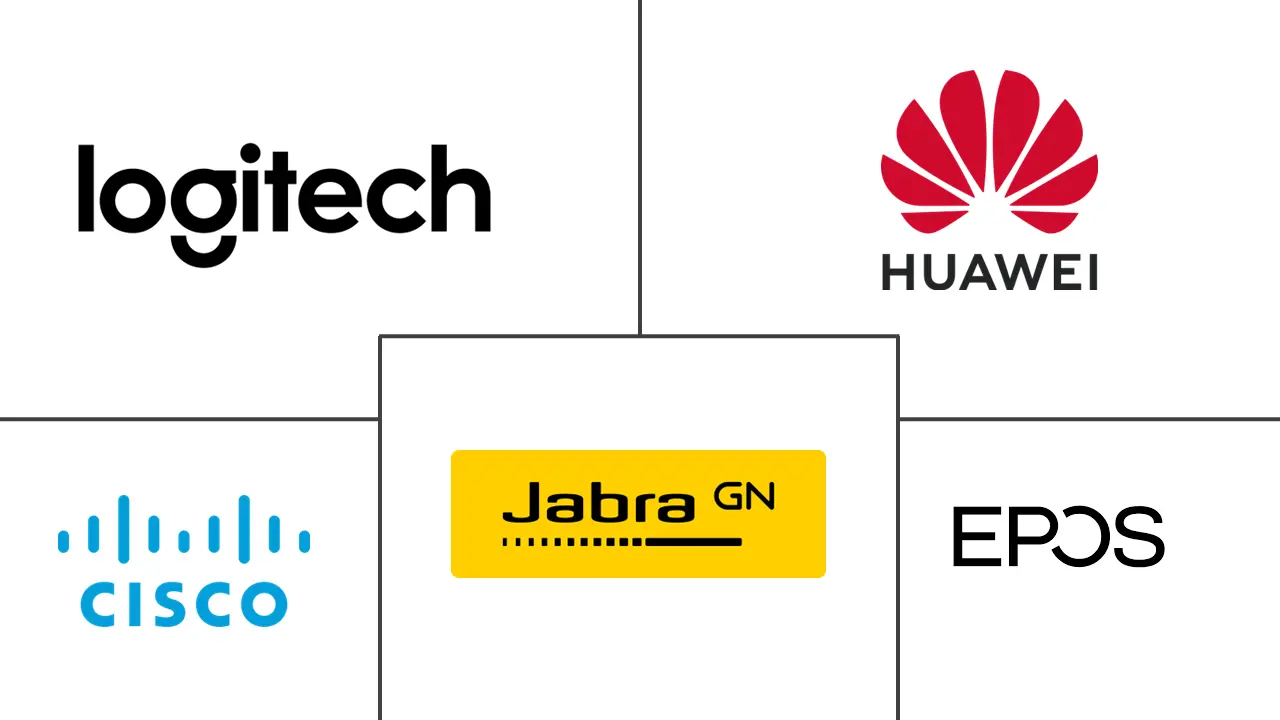Market Size of Middle East & Africa Video Conferencing Hardware Industry

| Study Period | 2022 - 2029 |
| Base Year For Estimation | 2023 |
| Market Size (2024) | USD 300 Million |
| Market Size (2029) | USD 590 Million |
| CAGR (2024 - 2029) | 14.50 % |
| Market Concentration | High |
Major Players
*Disclaimer: Major Players sorted in no particular order |
Middle East & Africa Video Conferencing Hardware Market Analysis
The Middle East & Africa Video Conferencing Hardware Market size is estimated at USD 300 million in 2024, and is expected to reach USD 590 million by 2029, growing at a CAGR of 14.5% during the forecast period (2024-2029).
The Middle East and Africa video conferencing hardware market growth is driven by institutions' continuous investment in the latest technology and enterprises' growing hybrid work culture. The market is changing drastically due to changes in the work culture and workplaces in the Middle East and Africa. Technological advancements in hardware such as cameras, MCUs, codec systems, enterprise headsets, and USB-based integrated bars drive the video conferencing hardware market.
Further, enterprise headsets gained traction in recent years owing to increased work-from-home and remote communication in the digital world. The continuous technological advancement in audio technology, including beamforming, noise cancellation, and high-fidelity audio capture, increases the demand for high-quality microphones across institutions and commercial spaces.
The demand for high-resolution cameras gained traction owing to the rising demand for remote collaboration solutions and the growth of the remote work culture drive. Continuous innovation and upgradation in the existing hardware create huge market opportunities. The advancement of MCUs accelerated group meetings, enabling the effortless integration of inputs from various sources. Further, modern MCUs integrate advanced features like transcoding that boost their potential to handle many participants with variable codec requirements bandwidth. Such features drive the hardware growth.
The adoption of video conferencing hardware in the Middle East and African institutions such as schools, colleges, and universities has significantly increased, especially during and after the pandemic, accelerating the shift to online learning. Also, the demand for better-quality cameras, headsets, and MCUs has accelerated and is expected to increase in the coming years.
An ongoing military and political conflict, as well as the Israeli–Palestinian conflict, has disrupted the whole Middle East and African economies. Owing to war, the countries are mainly focusing on the military and defense sectors, which is expected to reduce the market's growth. Such war and geopolitical tensions are anticipated to lower economic growth and increase inflation, leading to slow market growth.
Middle East & Africa Video Conferencing Hardware Industry Segmentation
The study tracks the revenue accrued through the sale of video conferencing hardware by various players in the Middle East and Africa. The study also tracks the key market parameters, underlying growth influencers, and major vendors operating in the industry, which will support the market estimations and growth rates during the forecast period. The study further analyses the overall impact of COVID-19 aftereffects and other macroeconomic factors on the market. The report’s scope encompasses market sizing and forecasts for the various market segments.
The Middle East and Africa video conferencing hardware market is segmented by product (multi control units (MCU), collaboration bars, codec systems, USB cameras, USB-based integrated bars, other bundled kits, and enterprise headsets), end users (institutions and commercial spaces), and country (Saudi Arabia, the United Arab Emirates, GCC except for UAE and Saudi Arabia, South Africa, and Rest of Middle East & Africa). The market sizes and forecasts regarding value (USD) for all the above segments are provided.
| By Type of Hardware | |
| Multi Control Units (MCU) | |
| Collaboration Bars | |
| Codec Systems | |
| USB Cameras | |
| USB-based Integrated Bars | |
| Other Bundled Kits | |
| Enterprise Headsets |
| By End User | |
| Institutions | |
| Commercial Spaces |
| By Country*** | |
| Saudi Arabia | |
| United Arab Emirates | |
| GCC | |
| South Africa |
Middle East & Africa Video Conferencing Hardware Market Size Summary
The Middle East and Africa video conferencing hardware market is experiencing significant growth, driven by the increasing adoption of hybrid work cultures and continuous investments in advanced technology by institutions and enterprises. The market is evolving rapidly due to technological advancements in hardware components such as cameras, MCUs, codec systems, enterprise headsets, and USB-based integrated bars. These innovations are enhancing the quality and efficiency of remote communication, with features like beamforming, noise cancellation, and high-fidelity audio capture boosting the demand for high-quality microphones. The rise in remote collaboration solutions and the shift towards online learning have further accelerated the demand for high-resolution cameras and other video conferencing equipment. However, geopolitical tensions and conflicts in the region pose challenges, potentially impacting economic growth and market expansion.
The commercial sector in countries like the UAE, Bahrain, Saudi Arabia, and South Africa is expected to hold a significant share of the market, as video conferencing becomes an essential tool for business communication, reducing travel costs and increasing productivity. The ongoing development of 5G networks and the integration of advanced video conferencing applications into hardware are creating new market opportunities. The UAE, with its thriving tech-based start-up culture and government initiatives to accelerate digital solutions, is at the forefront of this growth. The presence of major vendors like Jabra, Poly, Cisco Systems Inc., Logitech International SA, Huawei Technologies Co. Ltd, and EPOS, who are continuously launching new products and expanding their operations, further consolidates the market. These developments, coupled with strategic investments in AI and cloud technologies, are expected to drive the market forward in the coming years.
Middle East & Africa Video Conferencing Hardware Market Size - Table of Contents
-
1. MARKET INSIGHTS
-
1.1 Market Overview
-
1.2 Industry Attractiveness - Porter's Five Forces Analysis
-
1.2.1 Threat of New Entrants
-
1.2.2 Bargaining Power of Buyers/Consumers
-
1.2.3 Bargaining Power of Suppliers
-
1.2.4 Threat of Substitute Products
-
1.2.5 Intensity of Competitive Rivalry
-
-
1.3 Impact of COVID-19 Aftereffects and Other Macroeconomic Factors on the Market
-
-
2. MARKET SEGMENTATION
-
2.1 By Type of Hardware
-
2.1.1 Multi Control Units (MCU)
-
2.1.2 Collaboration Bars
-
2.1.3 Codec Systems
-
2.1.4 USB Cameras
-
2.1.5 USB-based Integrated Bars
-
2.1.6 Other Bundled Kits
-
2.1.7 Enterprise Headsets
-
-
2.2 By End User
-
2.2.1 Institutions
-
2.2.2 Commercial Spaces
-
-
2.3 By Country***
-
2.3.1 Saudi Arabia
-
2.3.2 United Arab Emirates
-
2.3.3 GCC
-
2.3.4 South Africa
-
-
Middle East & Africa Video Conferencing Hardware Market Size FAQs
How big is the Middle East & Africa Video Conferencing Hardware Market?
The Middle East & Africa Video Conferencing Hardware Market size is expected to reach USD 300 million in 2024 and grow at a CAGR of 14.5% to reach USD 590 million by 2029.
What is the current Middle East & Africa Video Conferencing Hardware Market size?
In 2024, the Middle East & Africa Video Conferencing Hardware Market size is expected to reach USD 300 million.

